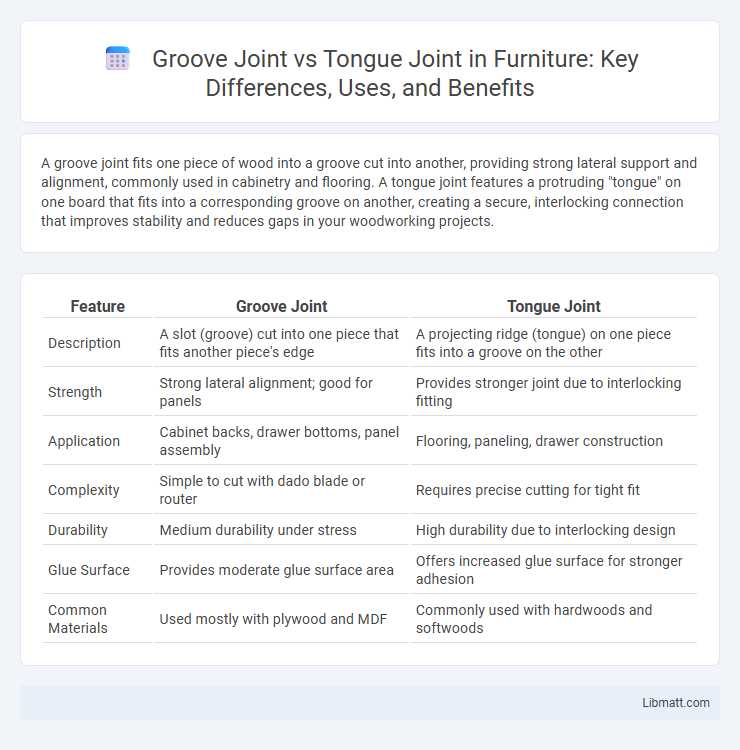A groove joint fits one piece of wood into a groove cut into another, providing strong lateral support and alignment, commonly used in cabinetry and flooring. A tongue joint features a protruding "tongue" on one board that fits into a corresponding groove on another, creating a secure, interlocking connection that improves stability and reduces gaps in your woodworking projects.
Table of Comparison
| Feature | Groove Joint | Tongue Joint |
|---|---|---|
| Description | A slot (groove) cut into one piece that fits another piece's edge | A projecting ridge (tongue) on one piece fits into a groove on the other |
| Strength | Strong lateral alignment; good for panels | Provides stronger joint due to interlocking fitting |
| Application | Cabinet backs, drawer bottoms, panel assembly | Flooring, paneling, drawer construction |
| Complexity | Simple to cut with dado blade or router | Requires precise cutting for tight fit |
| Durability | Medium durability under stress | High durability due to interlocking design |
| Glue Surface | Provides moderate glue surface area | Offers increased glue surface for stronger adhesion |
| Common Materials | Used mostly with plywood and MDF | Commonly used with hardwoods and softwoods |
Overview of Groove and Tongue Joints
Groove joints feature a recessed channel cut into one piece of wood that snugly fits the tongue of another, creating a strong, interlocking connection often used in cabinetry and flooring. Tongue joints involve a protruding ridge (the tongue) on one board that fits into the corresponding groove on another, enhancing alignment and stability in woodworking projects. Both joints improve structural integrity by increasing the glued surface area and providing precise alignment between wooden components.
Definition of Groove Joint
A groove joint involves a slot or groove cut into one piece of wood, allowing another piece to fit snugly within it, creating a strong, interlocking connection primarily used in cabinetry and furniture making. This joint enhances stability and alignment, making your woodworking projects more durable by distributing stress evenly across the joint. Compared to tongue joints, groove joints often provide better resistance to twisting and offer a cleaner fit for panels and frames.
Definition of Tongue Joint
A tongue joint, also known as a tongue-and-groove joint, features a protruding "tongue" on one board that fits precisely into a corresponding groove on another board, ensuring a tight and secure connection. This type of joint offers enhanced alignment, stability, and resistance to shearing forces, making it ideal for flooring, paneling, and cabinetry applications. You can rely on the tongue joint's design to create seamless and durable wood surfaces with improved structural integrity compared to simple butt joints.
Materials Used for Groove and Tongue Joints
Groove joints typically employ plywood, MDF, or hardwood to fit snugly into a corresponding groove, providing structural stability and resistance to warping. Tongue joints, made from solid wood like oak, maple, or pine, feature a projecting ridge designed to fit precisely into a matching groove, ensuring strong alignment and load distribution. Your choice between these joints should consider the material properties and intended application for optimal durability and craftsmanship.
Construction Techniques
Groove joint construction involves fitting a protruding groove into a matching slot, creating a strong interlocking connection often used in cabinetry and furniture making. Tongue joint techniques rely on a projecting tongue fitting snugly into a corresponding groove, enhancing alignment and stability in panel assembly. Your choice depends on the required strength and precision, with groove joints providing more surface area for adhesive, while tongue joints offer superior alignment for joining flat boards.
Strength and Durability Comparison
Groove joints offer moderate strength and durability by fitting one piece into a groove cut into another, providing resistance to lateral forces but less bonding surface compared to tongue joints. Tongue joints interlock precisely with a protruding tongue fitting into a corresponding groove, creating a stronger, more durable bond ideal for high-stress applications. Your choice between groove joint vs tongue joint should consider the structural demands, with tongue joints generally preferred for enhanced strength and longevity.
Common Applications
Groove joints are commonly utilized in cabinet making and drawer construction due to their strength and ease of assembly, often securing panels or shelves within frames. Tongue joints are frequently applied in flooring, paneling, and woodworking projects where a seamless, interlocking connection enhances stability and alignment. Both joints provide structural integrity but are chosen based on the specific requirements of the woodworking or construction task.
Advantages of Groove Joint
Groove joints offer superior alignment and stability by fitting one board into a recessed slot on another, reducing gaps and enhancing structural integrity. This joint type provides increased surface area for glue, resulting in a stronger bond compared to tongue joints. Groove joints also facilitate easier assembly and disassembly, making them ideal for cabinetry and flooring applications where precision and durability are essential.
Advantages of Tongue Joint
The tongue joint offers superior alignment and strength by interlocking wood pieces tightly together, reducing gaps and increasing structural stability in woodworking projects. This joint provides enhanced resistance to twisting and pulling forces compared to groove joints, making it ideal for applications requiring durability and precision. Its precise fitting also improves the aesthetic finish by creating seamless connections that minimize visible joints.
Groove Joint vs Tongue Joint: Key Differences
Groove joints feature a slot or groove cut into one piece to fit another, providing a strong mechanical connection ideal for cabinetry and paneling. Tongue joints have a protruding ridge (tongue) on one piece that fits into a corresponding groove on another, enhancing alignment and strength in wood joinery. The primary difference lies in the tongue's projection in tongue joints versus the groove-only design in groove joints, affecting ease of assembly and structural stability.
Groove joint vs tongue joint Infographic

 libmatt.com
libmatt.com